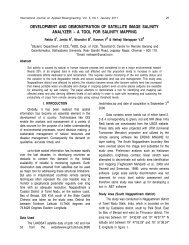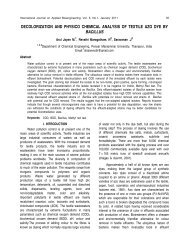Download Full Paper - Sathyabama University
Download Full Paper - Sathyabama University
Download Full Paper - Sathyabama University
You also want an ePaper? Increase the reach of your titles
YUMPU automatically turns print PDFs into web optimized ePapers that Google loves.
Balwinder Raj et al : Analytical Modeling of Nanoscale Double Gate FinFET Device<br />
Fig. 1. b. Cross section of 2D FinFET<br />
Series resistance<br />
As the fin width is reduced, the parasitic series<br />
resistance in the source and drain increases. If the gate is<br />
misaligned to the source and drain pads, the output<br />
characteristics can be changed significantly. A selective<br />
Ge deposition process was proposed to alleviate the effect<br />
of misalignment and to reduce the series resistance [15].<br />
The use of Ge is attractive because it is a low temperature<br />
process, which is important for future integration with high-<br />
K gate dielectrics and metal gates. Furthermore, Ge<br />
provides an in-situ cleaning effect because GeH4 can<br />
remove native oxide. On-current was enhanced to 28%<br />
with selective Ge raised S/D process [15]. For further<br />
reduction of series resistance, metal germanide such as<br />
nickel-germanide can be attractive [2].<br />
Reliability<br />
It is timely to investigate reliability of FD-SOI CMOS<br />
FinFETs. For suppression of short-channel effects, the fin<br />
width is as narrow as possible. However, it can be a big<br />
concern that the extremely narrow fin width would be<br />
desirable in the device reliability point of view. Thus, DC<br />
hot-carrier tests were performed to evaluate device<br />
reliability for various device dimensions. In the thicker body<br />
case, hot electrons are more strongly driven towards the by<br />
the 2D curvature of the potential. Thus, hot-carrier<br />
immunity is improved by thinning the body of a double-gate<br />
MOSFET, which also improves short-channel effects [2],<br />
[9].<br />
Parameters<br />
A basic structure of FinFET is shown in Figure 2,<br />
which describes the different parameters used for the<br />
modeling. The critical geometrical parameters of FinFET<br />
are shown. Also the definition of these parameters<br />
described in the MOS control box as used in the setup of<br />
analytical and numerical modeling.<br />
67<br />
L : physical gate length of FinFET, H : height of silicon fin,<br />
gate fin<br />
defined by the distance between top gate and buried<br />
oxides, T : thickness of silicon fin, defined by the distance<br />
fin<br />
between front and back gate oxides, L : effective channel<br />
eff<br />
length of FinFET is estimated by the metallurgical junction<br />
for abrupt junctions, W: geometrical channel width defined<br />
as<br />
W=2*H fin +T fin.<br />
t oxf:<br />
oxide thickness of the front gate;<br />
t oxb:<br />
oxide thickness of the back gate;<br />
Fig. 2. Cross-sectional view of FinFET along the channel<br />
Length [7].<br />
When Tfin is much larger than Hfin or when top gate<br />
oxide is much thinner than the front and back oxides,<br />
FinFET can be approximately treated as single-gate fully<br />
depleted SOI MOSFET (FDFET) as long as the silicon fin<br />
remains fully depleted. On the other hand, when Hfin is<br />
much larger than Tfin or top gate oxide is much thicker than<br />
the front and back oxides, FinFET can be approximately<br />
treated as DGFET. The two limits of FinFET, FDFET and<br />
DGFET, are widely studied and well understood, but in the<br />
regime where both fin height and fin thickness have control<br />
over SCE, the dependence of SCE on device dimensions<br />
is not well characterized. In order to establish the functional<br />
expressions of potential, analytical solution of 3D Laplace<br />
equation is used to derive the design equations for the<br />
subthreshold behavior of FinFET. Based on the 3D<br />
electrostatic potential distribution in the subthreshold<br />
region, potential modeling is done [7].<br />
III. POTENTIAL MODELING<br />
Electrostatic Potential in sub-threshold region can be<br />
describe by 3D Laplace equation [13].









